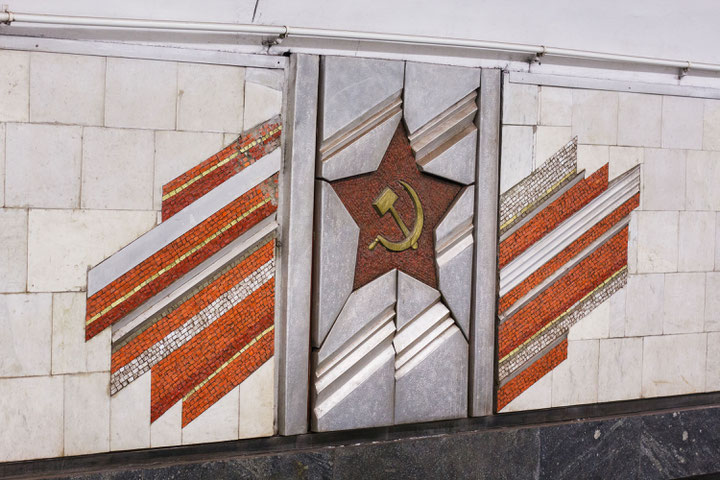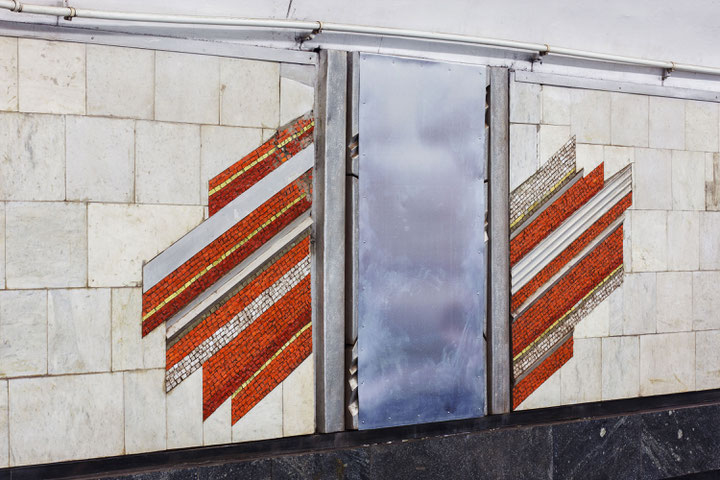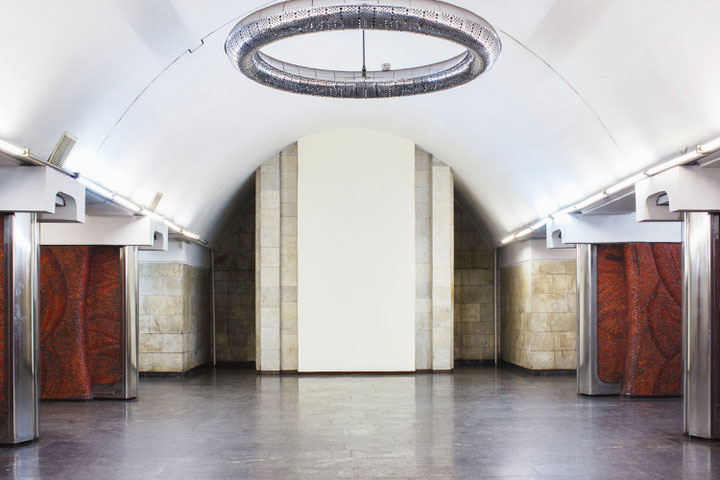Issue 4/2015 - Kiev, Moscow and Beyond
Struggling Against Icons
The Elimination of Soviet Monumental Art from Ukraine’s Public Realm
Monumental-decorative art, and especially mosaics, were a crucial area of Soviet art policy, most brilliantly developed in the 1960s. The technique is clearly marked by the tendencies of that time. It was a complicated and costly one, practicable only in an economically advanced country that sought to put its development, wealth, and might on display. The country also saw a boom in construction projects, and along with them came a demand for artworks to decorate public spaces. Monumental paintings soon appeared on train stations, hospitals, kindergartens, schools, metro stations, and so forth. Thirst for experimentation, and the quest for new technological solutions, were concentrated in monumental art, the officially sanctioned reflection of culture.
As far as the artists who actually created these decorations were concerned, their job was to fulfill propagandistic and ideological needs, using ideologically vetted subjects. But in doing this, they strove to escape conventional artistic methods, locating themselves instead within the search for new theories of artistic style, experimenting with new materials, and not infrequently belonging to unofficial artists’ clubs, laboring in their studios over decidedly non-Soviet works. In all, it was a period that saw the creation of innumerable colorful mosaics, realized with unique creative methods and, more often than not, simple, thematically accessible subjects. It was a unique cultural phenomenon, unlike almost anything else in Soviet – and even world – history.
In April 2015 the Ukrainian parliament adopted a new law that condemned “totalitarian, communist and Nazi regimes” and declared all symbols and propaganda associated with these regimes illegal. In this way, they legalized the process of removing the symbols of Soviet rule now being actively dispersed in Ukraine, especially in the bigger cities. On all levels of society, discussions ensued between cultural activists and politicians concerning the fate of the cultural legacy created during the Soviet era, and infused with prohibited symbolism. In post-Soviet countries, the practice of destroying these symbols has proceeded reasonably during transitions from a shared Soviet past to independence, and newly-formed states have tried to purge the memory of their connection to the Soviet Union in every way possible. Supporters of the destruction of Soviet symbolism have argued that radical steps will speed the process of helping the country to forget its past humiliations and collective existence, which was tied to the methodical destruction of Ukrainian identity. Further, those combatting Soviet symbolism seem persuaded that their struggle amounts to an act of rescue from the symbols of a government with which Ukraine is in a state of undeclared war, the heir to the Soviet Union’s political legacies. It may be said that one of the aims of these bans on all things Soviet is the cleansing of collective memory and the formation of a “new” historical truth. However, in the case of Ukraine, the processes of “decommunization” did not begin with the proclamation of independence in 1991, as one might expect. This is because the role of leading the country was long reserved for the former party leadership that was already involved in government, and a huge portion of the population, especially in the eastern regions, felt little urgency about removing Soviet symbols from public space. On the contrary, they considered these symbols a part of their identity.
It is also important to understand that the current conflict is not about the substance of ideology. Rather, it is a struggle with an external constituency, an unacceptable symbology that once served as a means for the promotion of communist ideology. But beneath this outer casing, vestiges of the past yet lie. The history of Ukraine includes many moments of conflict, and the new law, unfortunately, will not help to reconsider them; its effects will instead be limited to expunging the “unacceptable” parts of a history that is still producing new social conflicts.
In the struggle to preserve the prohibited symbols, one of the ideas that might be considered successful is the plan to create a so-called “Museum of Totalitarianism” in which to gather examples of the monumental art that served in Soviet times as a form of propaganda in public space and was distributed across the entire expanse of Ukraine. The law “on the condemnation of totalitarian regimes” includes a waiver clause for works of art from the Soviet period. The problem is that the mosaics most often are not registered as works of art, leaving the owners of the properties where they are situated free to deal with them at their own discretion – which may include painting over, razing, or covering them with ads. And if it is possible to enter into dialogues with city governments on an official level and address the situation, the matter reads tremendously differently to those of a radically nationalistic mindset, who have no compunction about deciding the fate of art in the style of China’s Cultural Revolution, or with the iconoclasm of the Byzantine Empire – that is, by barbaric methods.
Translated from Russian by Ian Dreiblatt
Translated by Helen Ferguson



